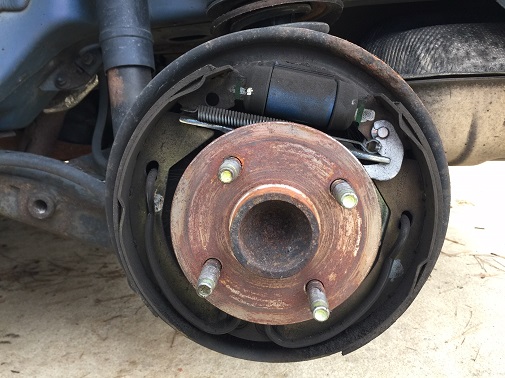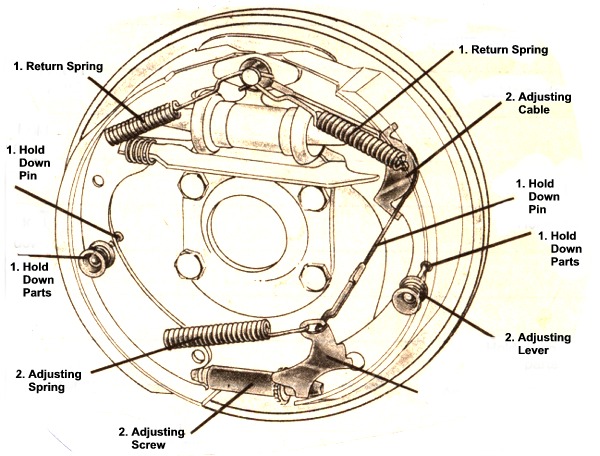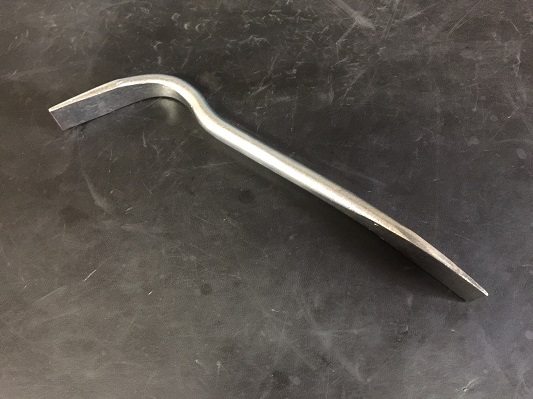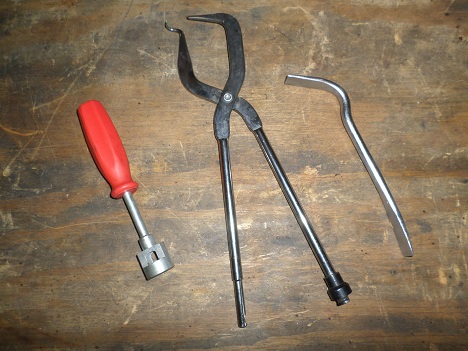Drum Brake and Shoes Overhaul
Article by Mark Trotta
The difference in stopping power with a newly-overhauled drum brake system is very noticeable, making your classic car safer and more enjoyable to drive. Drum brake restoration requires several speciality tools and an evening or two in the garage.

Drum brake systems are divided into two categories, friction and hydraulic. This article covers the friction parts, which include the brake drums, shoes, hold-down hardware, and parking brake cables.
Brake Drums
Brake drums are the most expensive part of the overhaul. Since warped or grooved drums effect brake performance, have yours measured to see if they can be resurfaced. Better auto parts stores still provide this service.
____________________________________________
____________________________________________
There are several types of brake drum construction. The most common is the one-piece cast iron style. Composite drums use a either a sheet-steel hub with an iron rim cast to it, or a sheet-steel drum with a cast iron surface inside it. Composite-style drums are lighter than cast-iron drums.
Aluminum naturally transfers heat better than cast iron, and is also lighter in weight. Many aluminum brake drums are actually bimetallic, manufactured from aluminum and cast iron. The Al-fin brake drum, once the hot set-up, used a special process for casting the aluminum around the iron.
Many sixties performance cars (Corvette's, GTO's, etc.) offered optional aluminum drums for lighter weight. Finned drums also dissipate heat (and look cool).
The larger the brake drum, the better it can dissipate heat. Larger drums also reduce brake-pedal effort. Back in the day, early racers and hot-rodders fit as big a drum brake as could fit inside the wheel.
Many old-school drag cars still run four-wheel drums because they're lighter than discs. They also have less drag - they back the adjusters all the way off for minimum rolling resistance. This is not recommended for street-driven cars!
Removing Brake Drums
Before you start banging on the back of your drum with a hammer, you may need a brake drum puller to remove them. Having a service manual for your year and model is always a good idea. Also, remember to disengage the parking brake while inspecting rear drums, as this will prevent the drum from coming off.
Replacing Brake Drums
Sometimes, drums can be machined. Other times, if your shoes have worn as far as the rivets, the drums may be scored or too thin to be machined. Depending on your year and model, replacement brake drums may be hard to find. Many drums may be available only as used, which may not be in any better shape than the ones you're replacing.
Brake Shoes
Brake shoe friction material varies. There are organic and several qualities of metallic linings. Friction material, or brake lining, is either bonded (glued) or riveted on the brake shoe. Many performance cars of the sixties offered sintered metallic brake linings for better stopping power.

The primary shoe (the one in front) is the shorter one. Do only one wheel at a time so if you forget how it came apart, you can use the other side as a guide to put all the pieces back together. Never work on just one brake - you'll get a sharp pull or worse.
____________________________________________
____________________________________________
When buying replacement shoes (usually sold as exchange), make sure all the holes in the new shoes line up with the old ones. If a return spring is placed in an improper hole, dragging or grabbing brakes will result. Keep in mind that shoes may have extra holes to fit applications other than yours.
Before installing the new shoes, consider cleaning and painting the backing plates. A spray can of black engine enamel would work fine. Remember to apply a small amount of all-purpose grease to the friction points on the backing plates to help the shoes move freely.
*******************************
Adjusting Brake Shoes After Installation
Most drum brake equipped vehicles have a window or slot on the back side of the backing plate. This allows access to the self-adjuster to manually adjust the brakes with a brake spoon. If there is no access slot, the wheel and drum must be removed to adjust the shoes.

Shop: Drum Brake Adjusting Tool
Some mechanics like to 'bed in' new brake shoes. This is done by a series of short, hard stops from about 30 mph, letting the brakes cool down (about 15 minutes), and then repeat the process once more.

Read: Drum Brake Tools
*******************************
Notes and Misc
Work on one side of the car at a time, using the other side as a reference.
Before re-installing brakes, clean and spray the backing plates with black engine paint.
Before re-installing wheels, a dot of Anti-Seize lubricant on wheel studs insures that wheels will come off easily in the future.
Apply a small amount of all-purpose grease to the friction points on the backing plates.
The parking brake is applied by a mechanical linkage, usually a cable or cables. The rubbing points on these should be lubricated as well.
Safety Concerns
Most older brake shoes were made with asbestos, whose debris is dangerous to your health. Wear a dust mask when removing old drums and shoes. Don't use compressed air to clean off brakes. Use brake parts cleaner and a wire brush.
____________________________________________
____________________________________________
With new parts and quality shoes, drum brakes work better than most people believe. The difference in stopping power with a newly-overhauled brake system is very noticeable, making your old car safer and more enjoyable to drive.
*******************************
Related Articles: